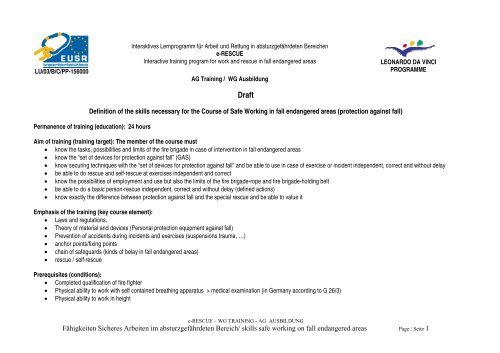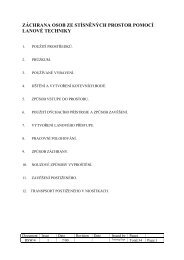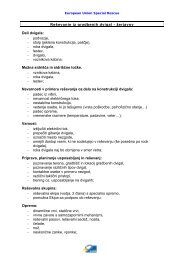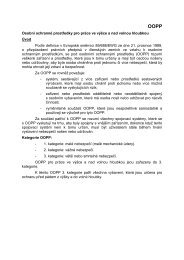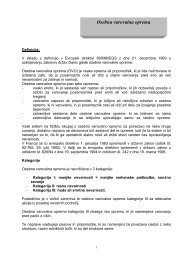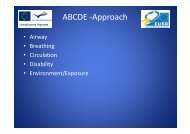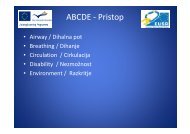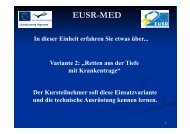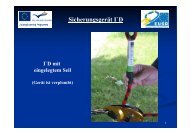Fall protection - EUSR
Fall protection - EUSR
Fall protection - EUSR
You also want an ePaper? Increase the reach of your titles
YUMPU automatically turns print PDFs into web optimized ePapers that Google loves.
LU/03/B/C/PP-156000<br />
Interaktives Lernprogramm für Arbeit und Rettung in absturzgefährdeten Bereichen<br />
e-RESCUE<br />
Interactive training program for work and rescue in fall endangered areas<br />
AG Training / WG Ausbildung<br />
Draft<br />
Definition of the skills necessary for the Course of Safe Working in fall endangered areas (<strong>protection</strong> against fall)<br />
Permanence of training (education): 24 hours<br />
LEONARDO DA VINCI<br />
PROGRAMME<br />
Aim of training (training target): The member of the course must<br />
• know the tasks, possibilities and limits of the fire brigade in case of intervention in fall endangered areas<br />
• know the “set of devices for <strong>protection</strong> against fall” (GAS)<br />
• know securing techniques with the “set of devices for <strong>protection</strong> against fall” and be able to use in case of exercise or incident independent, correct and without delay<br />
• be able to do rescue and self-rescue at exercises independent and correct<br />
• know the possibilities of employment and use but also the limits of the fire brigade-rope and fire brigade-holding belt<br />
• be able to do a basic person-rescue independent, correct and without delay (defined actions)<br />
• know exactly the difference between <strong>protection</strong> against fall and the special rescue and be able to value it<br />
Emphasis of the training (key course element):<br />
• Laws and regulations,<br />
• Theory of material and devices (Personal <strong>protection</strong> equipment against fall)<br />
• Prevention of accidents during incidents and exercises (suspensions trauma, …)<br />
• anchor points/fixing points<br />
• chain of safeguards (kinds of belay in fall endangered areas)<br />
• rescue / self-rescue<br />
Prerequisites (conditions):<br />
• Completed qualification of fire fighter<br />
• Physical ability to work with self contained breathing apparatus > medical examination (in Germany according to G 26/3)<br />
• Physical ability to work in height<br />
e-RESCUE – WG TRAINING - AG AUSBILDUNG<br />
Fähigkeiten Sicheres Arbeiten im absturzgefährdeten Bereich/ skills safe working on fall endangered areas Page / Seite 1
Nr. Thema/content Hours Main learning target<br />
the member of the training shall..<br />
1. Theory<br />
1.1 Main terms/Definitions 1 Know and be able to explain definitions<br />
and terms of “<strong>protection</strong> against fall”<br />
1.2 Tasks, possibilities and limits at<br />
incidents in fall endangered areas<br />
1 Know the difference concerning the use<br />
of fire brigade holding belt / fire brigade<br />
rope and set of devices for <strong>protection</strong><br />
against fall (GAS)<br />
Know the difference between AS<br />
(Protection against fall) and SRHT<br />
(Special rescues from heights and<br />
depths)<br />
1.3 accident prevention regulation 1 Know accident prevention regulation/ is<br />
able to transfer to incident situations<br />
Training contents Training methods<br />
<strong>Fall</strong> factor, Impact force, italian hitch,<br />
Protection against fall (AS), Special rescues<br />
from heights and depths (SRHT), …<br />
Possibilities and limits of employment<br />
Differences between to hold (back), to catch a<br />
fall, rescue/self-rescue and Special rescues<br />
from heights and depths (SRHT)<br />
specialities<br />
General behaviour during the training/incident<br />
Behaviour at exercise objects<br />
Handling with the equipment<br />
Behaviour in special situations<br />
Suspensions trauma<br />
Working material AS (<strong>protection</strong> against fall)<br />
FwDV 1/2 Kapitel 14 und 15<br />
GUV-R 198; GUV R-199<br />
GUV V C53; GUV- G 9102<br />
Training discussion<br />
Training discussion<br />
Training discussion<br />
e-RESCUE – WG TRAINING - AG AUSBILDUNG<br />
Fähigkeiten Sicheres Arbeiten im absturzgefährdeten Bereich/ skills safe working on fall endangered areas Page / Seite 2
Nr. Theme / content Hours Main learning target<br />
the member of the training shall..<br />
1.4 Personal <strong>protection</strong> equipment<br />
(PSA)against fall<br />
1.4.1 Theory of ropes 2 Know kinds of ropes and be able to<br />
describe and explain its limitations of<br />
use<br />
Be able to describe and explain<br />
interventions with ropes<br />
Be able to do a correct maintenance<br />
and to make out proofs of ropes and<br />
also recognize damaged ropes<br />
1.4.2 Material and tool science be able to<br />
declare and describe material and tools<br />
for doing rescue and self-rescue as well<br />
as GAS (set of devices for <strong>protection</strong><br />
against fall)<br />
maintenance/Service according to the<br />
norms/ regulations, knowledge of the<br />
proof of done service<br />
recognize defect tools and devices<br />
Training contents Training methods<br />
kinds of ropes and properties<br />
Construction/ production of the rope<br />
Technical figures, characteristics<br />
Maintenance/ Service / elimination<br />
Handling of ropes<br />
Limits for loads, forces, …<br />
Possibilities of damage / <strong>protection</strong><br />
Fire brigade holding belt / ~ rope<br />
harness to catch fall/ to fix to rope EN 361<br />
dynamic ropes EN 892<br />
slings<br />
Carbines for intermediate belay, fixing points<br />
HMS Carbines with twin lock<br />
Rescue triangle<br />
Self safeguard (Form: Y or V)<br />
technical data<br />
purpose of use<br />
Maintenance/ Service / elimination<br />
Training methods<br />
Experiments to<br />
tear/break ropes<br />
e-learning<br />
e-RESCUE – WG TRAINING - AG AUSBILDUNG<br />
Fähigkeiten Sicheres Arbeiten im absturzgefährdeten Bereich/ skills safe working on fall endangered areas Page / Seite 3
Nr. Theme / content Hours Main learning target<br />
the member of the training shall..<br />
1.5 knots 1 Declare different knots and describe the<br />
use<br />
Knows fundamental principles by<br />
making and using knots<br />
1.6 Technique of safeguards 2 know and use the kinds of safeguard<br />
and its differences at training and in the<br />
case of intervention and be able to<br />
transfer it to similar situations<br />
know and use safeguard principles<br />
1.7 Written examination 1<br />
Training contents Training methods<br />
Construction and function<br />
possibility of use<br />
Kind of knots<br />
Clove hitch<br />
bowline<br />
larks foot<br />
thumb knot/ overhand<br />
figure of eight knots<br />
italian hitch<br />
Kinds of belay:<br />
Chain of belay<br />
directly belay<br />
indirectly belay<br />
static belay<br />
dynamic belay<br />
construction / function<br />
physical effects<br />
particularities<br />
principles of belay<br />
Training discussion<br />
Teamwork<br />
e-learning<br />
Training discussion<br />
e-learning<br />
examination<br />
e-RESCUE – WG TRAINING - AG AUSBILDUNG<br />
Fähigkeiten Sicheres Arbeiten im absturzgefährdeten Bereich/ skills safe working on fall endangered areas Page / Seite 4
Nr. Theme / content Hours Main learning target<br />
the member of the training shall..<br />
2.1 Preparation of exercises 1 Be introduced to significant problems<br />
and specifications of different exercises<br />
and incidents<br />
Get a introduction for objects especially<br />
of the locality<br />
2.2 knots 2 Be able to use and have command over<br />
the knots for securing against fall in<br />
every situation<br />
2.3 Safeguard in fall endangered areas 5 Be able to do activities of Safeguard in<br />
fall endangered areas and to have<br />
command over it<br />
Training contents Training methods<br />
Analysis of endangered of objects Practice instruction<br />
Construction of knots<br />
Fixing to rope<br />
Fixing to anchor points<br />
To tie<br />
Clove hitch<br />
bowline<br />
larks foot<br />
thumb knot/ overhand<br />
figure of eight knots<br />
italian hitch<br />
Dangers while doing belay<br />
Principles of belay<br />
Kinds of belay<br />
Construction of the chain of belay<br />
Self safeguard<br />
Fixing points<br />
Employment/ engagement in heights<br />
Practice instruction<br />
Practice instruction<br />
Exercises of incidents<br />
e-RESCUE – WG TRAINING - AG AUSBILDUNG<br />
Fähigkeiten Sicheres Arbeiten im absturzgefährdeten Bereich/ skills safe working on fall endangered areas Page / Seite 5
Nr. Theme / content Hours Main learning target<br />
the member of the training shall..<br />
2.4 Rescue and self-rescue 4 • Be able to recognize the dangers<br />
of heights and depths<br />
• Have command over rescue and<br />
self-rescue and be able to do it<br />
independent and explain it<br />
2.5 Control of the equipment 1 Be able to check independent the<br />
existing equipment after exercises and<br />
Total theory/practice 11/ 13<br />
total 24<br />
incident<br />
Training contents Training methods<br />
• Dangers during rescue actions<br />
• Fifing points<br />
• Limits of the possibilities to do rescues<br />
• Rescue after a fall into the rope<br />
• Self-rescue<br />
• Self-safeguard<br />
The wording of the main learning target is taken over from the fire-brigade regulation 2 (FwDV 2) (see attachment).<br />
Control of the equipment<br />
Giving back tools and materials<br />
• Practice instruction<br />
• Exercises of<br />
incidents<br />
Practice instruction<br />
e-RESCUE – WG TRAINING - AG AUSBILDUNG<br />
Fähigkeiten Sicheres Arbeiten im absturzgefährdeten Bereich/ skills safe working on fall endangered areas Page / Seite 6
Level of training target (training aim stages) in the realization range (source: FwDV 2)<br />
Within the fore mentioned training aim ranges there are 4 different Levels of training targets (training aim stages)<br />
Level of training target 1 knowledge, in the sense of “being able to name"<br />
Level of training target 2 understanding, in the sense of “being able to describe and/or explain with own words"<br />
Level of training target 3 practise, in the sense of “being able to transfer anything witch was understood once to similar situations”<br />
Level of training target 4 evaluation, in the sense of “being able to value and justice new situations, the value of material, methods and procedures for certain<br />
situations”<br />
For reaching the respective Level of training target (training aim stages) following methods of instruction are necessary:<br />
LTT: target Method of instruction wording<br />
LTT 1: knowledge Minimum lecture<br />
Training discussion if there is<br />
enough time<br />
LTT 2: understanding Training discussion<br />
Work in team/ with partner<br />
LTT 3: Use/ practise Work in team/ with partner<br />
exercise, exercise with<br />
divided parts, Specimen of<br />
instruction<br />
LTT 4: evaluate Work in team/ with partner<br />
exercise , exercise with<br />
divided parts<br />
- must be able to name,<br />
- must be able to show/<br />
reproduce<br />
-have to be able to explain,<br />
-have to be able to describe<br />
Have to be able to transfer and<br />
to use to similar situations the<br />
subjects with were taught<br />
- must be able to judge the<br />
subjects with were taught,<br />
- must be able to derive<br />
measures<br />
e-RESCUE – WG TRAINING - AG AUSBILDUNG<br />
Fähigkeiten Sicheres Arbeiten im absturzgefährdeten Bereich/ skills safe working on fall endangered areas Page / Seite 7
Level of training target (training aim stages) in the action / behaviour range (source: FwDV 2)<br />
If the aim of the training is in the range of action/behaviour, there are also 4 different Levels of training target (training aim stages)<br />
Level of training target 1 Imitation, in the sense of "being able to do activities and handle the same grips, which are demonstrated by the instructor "<br />
(However it can never be the purpose of fire-brigade training, that the course participant can only copy activities!)<br />
Level of training target 2 Independent acting, in the sense of "being able to independent proceed of activities”<br />
Level of training target 3 Precision, in the sense of "being able to do activities not only independent and correct, but beyond that briskly and accurately"<br />
Level of training target 4 Automation of action, in the sense of "being able to do activities in every situation fast, without error and absolutely safe"<br />
For reaching the respective training aim stages methods of training the following specified methods of instruction are necessary:<br />
LTT: Target Method of instruction wording<br />
LTT 1: Imitation Practice instruction must be able to copy actions<br />
LTT 2: Independent acting Practice instruction<br />
must be able to accomplish or<br />
(PU step 3*)<br />
Station training<br />
proceed entirely courses of<br />
action without instructions ;<br />
LTT 3: Precision Practice instruction<br />
must be able to accomplish<br />
(PU step 4*)<br />
and explain technically<br />
correctly and independently<br />
Station training<br />
entire courses of action s<br />
LTT 4: Automation of action Practice instruction<br />
must be able to have<br />
(PU step 4*)<br />
Station training<br />
Operation exercises<br />
Exercises on model<br />
command over courses of<br />
action in every situation<br />
e-RESCUE – WG TRAINING - AG AUSBILDUNG<br />
Fähigkeiten Sicheres Arbeiten im absturzgefährdeten Bereich/ skills safe working on fall endangered areas Page / Seite 8


